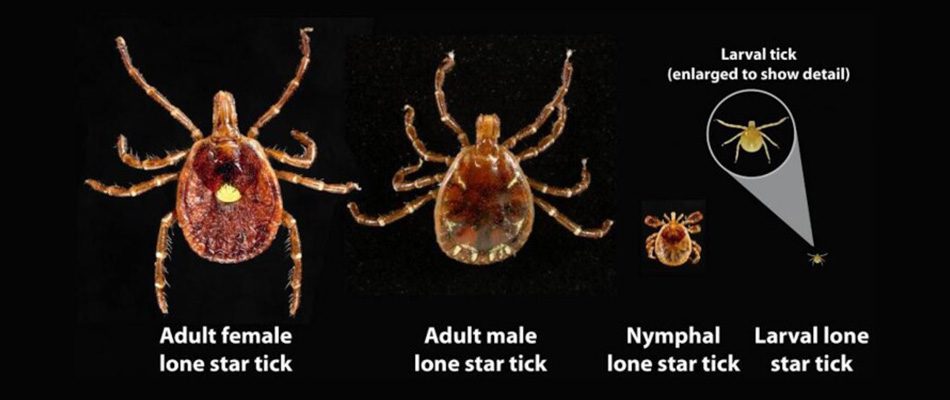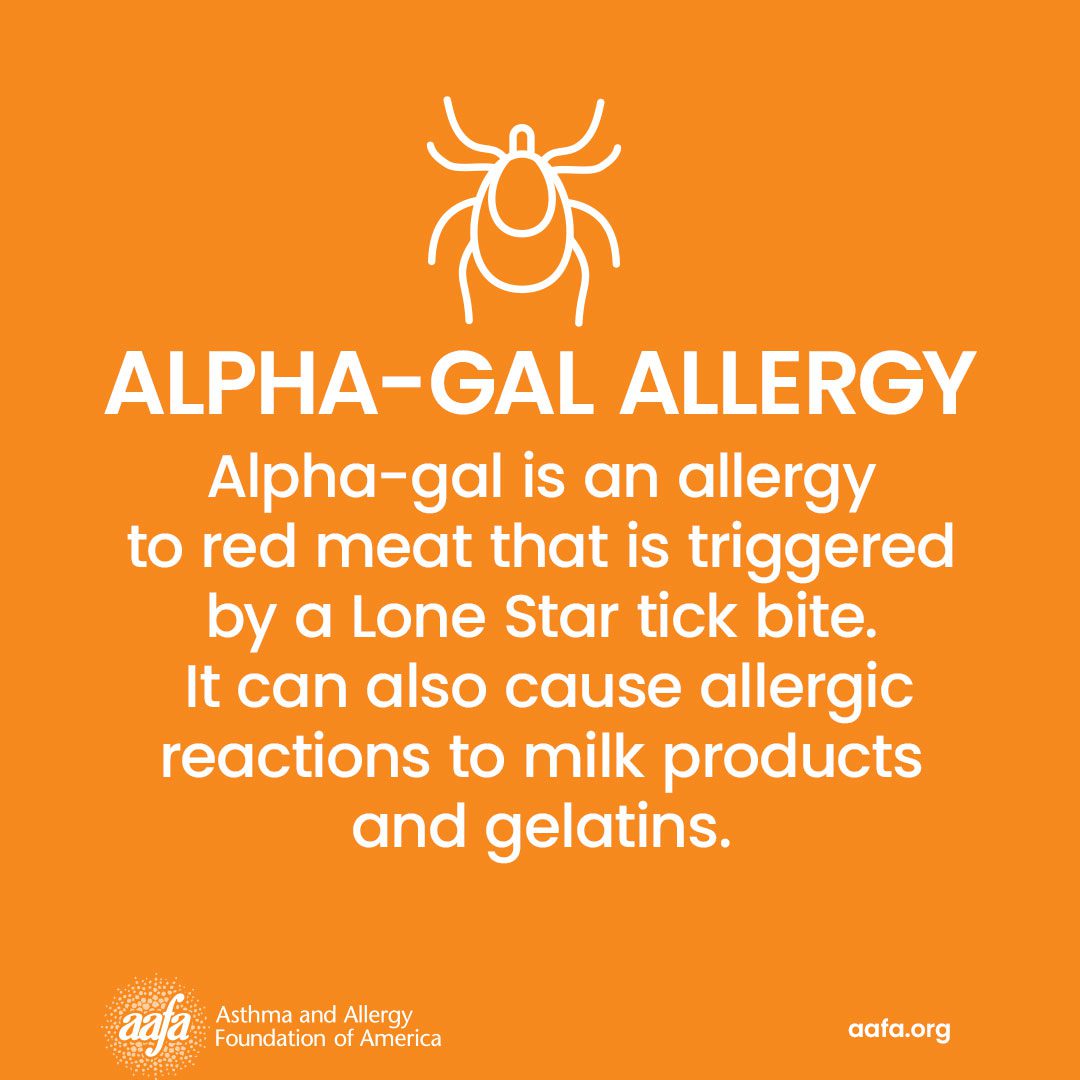Allergies
Alpha-Gal Syndrome, Lone Star Tick Allergy, and Red Meat Allergy
A bite from a tick can cause people to develop an allergy to mammalian meat. These ticks carry alpha-gal (a sugar). When a tick bites a person, it transfers alpha-gal into the bloodstream. The person’s immune system then reacts to it. Alpha-gal is also found in mammal meat such as beef, lamb, and pork. Though less frequent, some patients can react to milk and gelatin containing products.1
Lone Star ticks are aggressive biting insects that live in areas of dense vegetation, and attack larger animals, such as dogs, coyotes, deer, cattle, and humans. These insects are mainly active from April to late August. Lone Star ticks are widely distributed in the eastern, southeastern, and south-central United States. Though most commonly associated with the Lone Star tick, there is preliminary evidence that up to 8 additional tick species may also be associated with alpha-gal allergy. Alpha-gal syndrome (AGS), a serious allergic condition, is now reported on every continent other than Antarctica.2,3
What Is Alpha-Gal Allergy, Also Known as Alpha-Gal Syndrome?
When a Lone Star tick, or other identified ticks bite a person, it transfers alpha-gal through its saliva into the person’s bloodstream. Alpha-gal is an allergen for many people. An allergen is a substance that causes an allergic immune reaction.4
Red meat, such as beef, pork, and lamb, also contains alpha-gal. After the tick bite occurs, you may become sensitized to alpha-gal. An allergic reaction may then occur when you eat meat or by are bitten by ticks again. Milk, other dairy products, and gelatin may also contain alpha-gal and in rare cases cause an allergic reaction.1
Having an alpha-gal allergy does not mean that you need to adopt a full vegetarian diet. You can still eat poultry and fish. Also keep in mind that there is the possibility that your sensitivity to alpha-gal will diminish over time. But this may take many years.6
Lone Star ticks are aggressive and will bite anyone who comes near them. Since they dwell in wooded areas and high grass, landscapers, outdoor workers, and hikers are at an increased risk of being bit.7
What Are the Symptoms of Alpha-Gal Syndrome?
Most people bitten by insects have pain, redness, itching, and minor swelling in the area around the bite. This is a normal reaction. Most people get better within hours or days.
Symptoms of alpha-gal allergy include:6
- Hives or itchy rash
- Severe stomach pain, nausea, vomiting, or diarrhea
- Heartburn or indigestion
- Cough, shortness of breath, or difficulty breathing
- Drop in blood pressure
- Swelling of the lips, throat, tongue, or eye lids
- Dizziness
- Loss of consciousness
The most severe systemic reaction (affects the whole body) is anaphylaxis [anna-fih-LACK-sis]. Anaphylaxis is a serious allergic reaction that can progress rapidly. It can present as a combination of several of these symptoms. Anaphylaxis needs immediate medical care.6
Symptoms usually start 3 to 6 hours after eating red meat and may vary from person to person.
How Do Doctors Diagnose Alpha-Gal Syndrome?
To diagnose an allergy to alpha-gal, your doctor may give you a physical exam and discuss your symptoms and your history of tick bites and allergic reactions. The onset of the allergic reaction is usually delayed which makes it hard to associate your symptoms with eating red meat many hours beforehand.4,6
If your doctor thinks you have alpha-gal syndrome they may suggest a blood test.8 They may also suggest a skin test to evaluated for an allergy to meat.
Skin prick test (SPT) – In prick/scratch testing, a small drop of the possible allergen is placed on your skin. Then the nurse or doctor will lightly prick or scratch the spot with a needle through the drop. If you are sensitized to the substance, you will develop redness, swelling, and itching at the test site within 20 minutes. You may also see a wheal. A wheal is a raised, round area that looks like a hive.
A positive SPT to a particular allergen does not necessarily mean you have an allergy. Health care providers must compare the skin test results with the time and place of your symptoms to see if they match.
Specific IgE blood test – Blood tests are helpful when people have a skin condition or are taking medicines that interfere with skin testing. They may also be used in children who may not tolerate skin testing. Your doctor will take a blood sample and send it to a laboratory. The lab adds the allergen to your blood sample. Then they measure the amount of antibodies your blood produces to attack the allergens. This test is called specific IgE (sIgE) blood testing (commonly referred to as RAST or ImmunoCAP testing). As with skin testing, a positive blood test to an allergen does not necessarily mean that an allergen caused your symptoms.
What Is the Treatment for Alpha-Gal Syndrome?
Immediate symptoms of alpha-gal such as hives, swelling, light-headedness, or shortness of breath, can be treated in an urgent care setting with epinephrine (first), antihistamines, and oral corticosteroids [kor-tick-OH-stair-ROID].4
Some allergic reactions may become severe and cause systemic reactions such as anaphylaxis. If you experience symptoms of anaphylaxis, you should immediately use epinephrine.
Epinephrine can reverse severe systemic reactions and is the most important treatment available for anaphylaxis. If you have a severe alpha-gal allergy, you should carry an easy-to-use form of epinephrine. You should also consider wearing a medical identification bracelet or necklace containing information about your allergy.4
Omalizumab (Xolair®) is a monoclonal antibody (a type of protein made in the laboratory that targets specific molecules, activating or inhibiting their function). Omalizumab is indicated in adults and children aged one year and older for the reduction of allergic reactions to food allergens, including anaphylaxis. People prescribed omalizumab should still avoid the food allergen while taking the medication. Omalizumab should not be used for the emergency treatment of allergic reactions, including anaphylaxis.9 Some studies suggest that omalizumab may be helpful to reduce symptoms of alpha-gal allergy such as urticaria.10,11
Immunotherapy [eh-mu-no-THER-ah-pee] (a therapy in which patients are given small doses of an allergen to help the body to build natural immunity to it) for alpha-gal is not currently available. However, it is important to remember that scientific research is always advancing, and treatment options may change as new treatments are discovered. Oral immunotherapy for alpha-gal has shown promising results in clinical studies and may be a treatment option in the future.12,13
How Can I Prevent Allergic Reactions to Ticks?
If you have a known alpha-gal allergy, then you should carry an easy-to-use form of epinephrine [ep-uh-NEF-rin], so you can quickly treat a reaction wherever you are.6
You should avoid eating any red meat, such as beef, pork, lamb, goat, venison, rabbit, or other meat from mammals. In very rare cases the reaction may extend to milk, dairy products, or gelatin. If this is your case, then you should avoid these products too.1
Also, keep in mind that the best way to prevent allergic reactions to ticks is to prevent tick bites. Before you go outdoors, consider treating your shoes, clothes, and gear with permethrin (an insecticide) or buying pre-treated items. When outdoors, wear long sleeved shirts and pants, avoid areas with dense vegetation, and walk in the center of trails. Use appropriate insect repellants. After you come indoors, perform a thorough check of your clothing, gear, and pets for ticks.5,6
If you find a tick attached to your skin, remove it carefully and as soon as possible. First, clean the site with rubbing alcohol, and then use tweezers to pull the tick’s head up slowly from the skin using steady pressure. Clean your hands and the site one more time, and do not crush the tick between your fingers.6
How Can I Identify Lone Star Ticks?

Source: CDC
In the United States, the Lone Star tick can be found in the eastern, southeastern, and south-central states. Both adult males and females have a reddish-brown color and have an oval and flat body with eight prominent legs. Female adults are easy to identify by a single white dot, or “lone star,” in the center of the body. Male adults are smaller than the females and have white spots around the outer edge of the body. After feeding for several days (usually a week to 10 days), adult females can have an engorged, slate gray appearance.4,7
Adults are active from April to late August. Lone Star ticks are often found searching for larger animals, such as dogs, cattle, or humans, in leaf litter on the forest floor, or in partly shaded tall grass, tips of low-lying branches, and twigs.7
Closed
References
- Centers for Disease Control and Prevention. (2024, May 15). Products That May Contain Alpha-gal. Retrieved April 22, 2025, from: https://www.cdc.gov/alpha-gal-syndrome/data-research/products-containing-alpha-gal/index.html
- Thompson, J. M., Carpenter, A., Kersh, G. J., Wachs, T., Commins, S. P., & Salzer, J. S. (2023). Geographic Distribution of Suspected Alpha-gal Syndrome Cases — United States, January 2017–December 2022. Morbidity and Mortality Weekly Report, 72(30). https://doi.org/10.15585/mmwr.mm7230a2
- Ailsworth, S. M., Susi, A., Workman, L. J., Ji, Y.-S., Patel, J., Nelson, M. R., Platts-Mills, T. A. E., Nylund, C. M., & Wilson, J. M. (2024). Alpha-Gal IgE Prevalence Patterns in the United States: An Investigation of 3,000 Military Recruits. The Journal of Allergy and Clinical Immunology: In Practice, 12(1), 175-184.e5. https://doi.org/10.1016/j.jaip.2023.10.046
- Yale Medicine. (n.d.). Alpha-gal Syndrome (AGS). Retrieved April 22, 2025, from: https://www.yalemedicine.org/conditions/alpha-gal-syndrome-ags
- Centers for Disease Control and Prevention. (2024, May 15). Managing Alpha-gal Syndrome. Retrieved April 22, 2025, from: https://www.cdc.gov/alpha-gal-syndrome/managing/index.html
- American Academy of Allergy Asthma & Immunology. (2025, January 10). Alpha-gal and Red Meat Allergy. Retrieved April 22, 2025, from: https://www.aaaai.org/tools-for-the-public/conditions-library/allergies/alpha-gal-and-red-meat-allergy
- University of Rhode Island. (n.d.). Lone Star Tick. Retrieved April 22, 2025, from: https://web.uri.edu/tickencounter/species/lone-star-tick/
- Centers for Disease Control and Prevention. (2024, May 15). Clinical Testing and Diagnosis for Alpha-gal Syndrome. Retrieved April 22, 2025, from: https://www.cdc.gov/alpha-gal-syndrome/hcp/diagnosis-testing/index.html
- (2024). XOLAIR Prescribing Information. https://www.gene.com/download/pdf/xolair_prescribing.pdf
- Commins SP. (2020). Diagnosis & management of alpha-gal syndrome: lessons from 2,500 patients. Expert Review of Clinical Immunology, 16(7), 667–677. https://doi.org/10.1080/1744666x.2020.1782745
- Kondo, M., Matsushima, Y., Iida S., Umaoka A., Nakanishi T., Habe K. & Yamanaka, K. (2021). A Case of α-Gal-Unrelated Red Meat-Induced Urticaria Treated by Omalizumab. Case Reports in Dermatology, 13 (3), 437–440. https://doi.org/10.1159/000518421
- Ünal, D., Eyice-Karabacak, D., Kutlu, A., Demir, S., Tüzer, C., Arslan, A. F., Işık, S. R. & Gelincik, A. (2023) Oral immunotherapy in alpha-gal red meat allergy: Could specific IgE be a potential biomarker in monitoring management?. Allergy, 78(12), 3241-3251. https://doi.org/10.1111/all.15840
- Macdougall J. D., Thomas K. O., Iweala, O. I. (2022). The Meat of the Matter: Understanding and Managing Alpha-Gal Syndrome. ImmunoTargets and Therapy, 15(11), 37–54. https://doi.org/10.2147/ITT.S276872
Med Communications, Inc. assisted with development and review of medical content. Medical review: April 2025 by Jeffrey G. Demain, MD.












